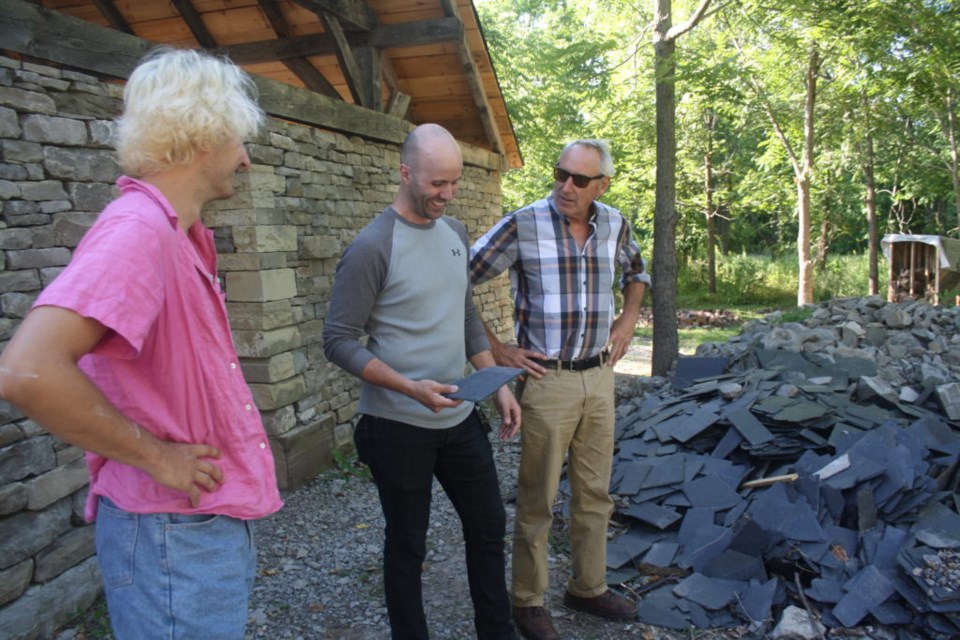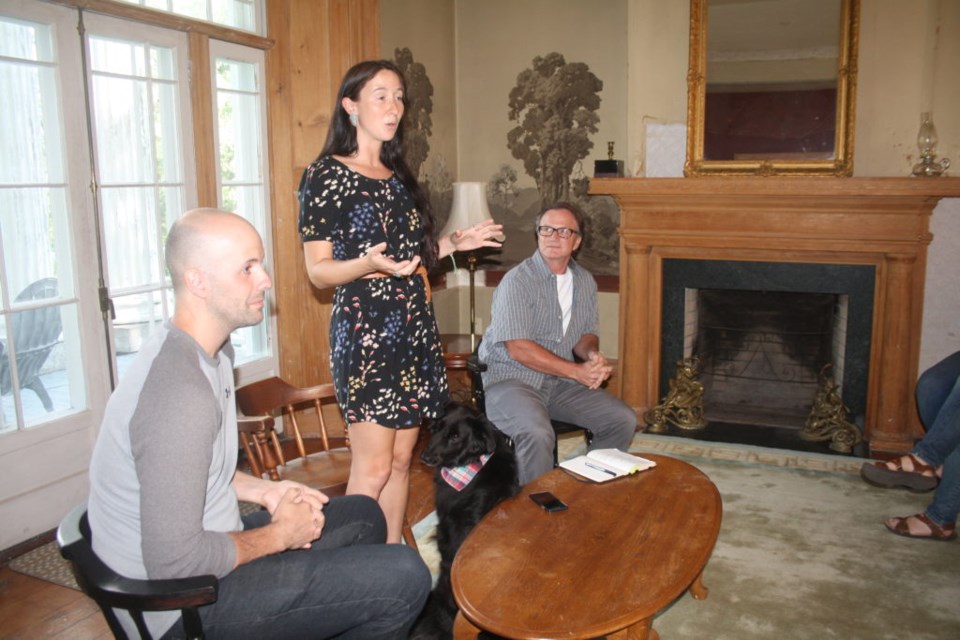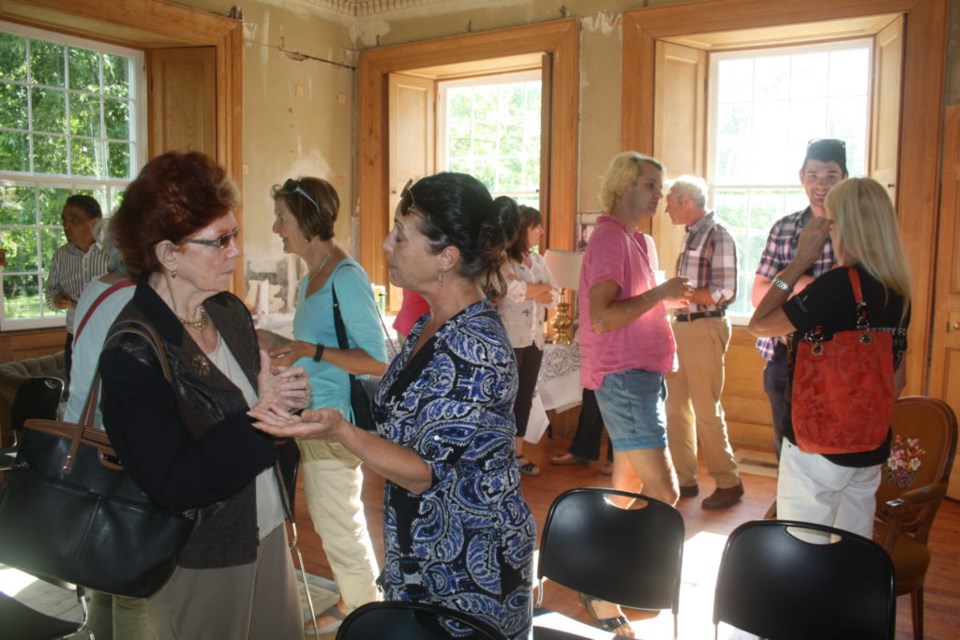
Staff at Willowbank Estate in Queenston are determined to achieve financial sustainability for the school of restoration arts, with a host of revenue-generating ideas for the future that include the Laura Secord campus.
They are also committed to reaching out to the villagers for their thoughts, in an effort to include them in their plans and avoid anything that might not suit the community.
At a community engagement open house held at Willowbank last Thursday, managing director Craig Crane told about 20 Queenston residents he wants to continue the discussion that began in April, at an event in the Bright Parlour. It had been a terrible evening, he said, but about 20 residents braved the elements and helped lay the groundwork for improving communication and community relationships.
With Crane last week were Cait Wooll, the voice on the Willowbank end of the phone who answers all kinds of queries, with an official title of education co-ordinator; and former student Andrew Bowers, now a full-time staff member who uses his skills to provide everything from building maintenance to teaching assistance.
“I’m the liaison between Cait and Craig,” he said. “I do whatever they need. I do whatever anybody needs.”
At the April meeting, Wooll said, the message from residents was a desire for better communication about what is going on at Willowbank, more interaction between the school and residents for events, and seeing the estate site cleaned up.
“We’re on it,” she said.
In laying out his plans for some changes at Willowbank, Crane told the villagers he hopes to have quarterly sessions with them. While this one was intended to provide a general update on goings-on at the school, those in the future would likely each focus on a specific topic of interest to locals.
As one of the revenue-generating ideas, he said, the blacksmith shop is relocating, and the forge building, with its drystone walls and slate roof, will be available for rental.
The renovated lower floor of the main house, which includes a new kitchen, and the grounds can also be rented for events, with local caterer Robin Howe taking the lead on that initiative. The lower floor, looking better than it ever has, is being used as a wedding venue, although only twice so far, but they would like to see more such events.
But it doesn’t have to be just weddings — the building would be suitable for smaller gatherings, such as book clubs. “We’d love to bring that kind life back to Willowbank,” Crane said.
A massive, $800,000 renovation to the main building is almost complete, and will allow for some classroom space to return, he said.
The third floor is closed off at the moment, and will be part of the next stage of the renovation, which has already addressed accessibility with the installation of an elevator.
To be used as part of the school, the top floor will need a fire exit, Crane said.
The renovations continue to provide a challenge of making a 200-year-old building conform to modern-day building codes, he explained.
“In 2009, when I first heard about Willowbank, it was portrayed as a living laboratory, with students working on the building as part of their learning,” he said. “The students are learning about that struggle. Things sometimes have to be slowed down while you figure it out.”
The recent work, including the installation of a new heating system, had to be done by professionals, but updating the third floor will once again have the students involved.
The other project on the horizon is determining the use of the former Laura Secord Memorial School, referred to as the south campus. In 2012, Willowbank, with the help of the Town, was able to purchase the property from the District School Board of Niagara, which closed the small elementary school. In its final days it had offered Junior Kindergarten to Grade 3 for students from Queenston, St. Davids and the surrounding rural area, but an addition in St. Davids Public School opened up capacity for those grades.
Part of the Queenston property was designated for residential development, and the Town kept a portion as a community park.
Over the next eight months, Crane plans for design students to visit the lower campus, a stone’s throw down the hill from the estate, to come up with some possible uses for it, with a goal of generating revenue.
“We want it to be an educational use — it has always been used for education,” said Crane.
Residents will be asked to give their feedback as well.
“We want to do the right thing for Queenston, and the right thing for Willowbank. That’s why we’re here.”
The feedback gathered last April, he said, “was very important to us. We’ve taken it to heart, and it will very much be part of the process moving forward.”
Willowbank has just two sources of income, relying solely on donations and tuition, “but that’s going to change. It has to.”
Asked about raising tuition to become more sustainable, Bowers, a graduate of the three-year program, said he had to remortgage his house to attend. He explained the school’s unique curriculum, which makes it the only school of its kind in Canada, doesn’t allow students to access any financing, either through banks, or through Ontario Student Assistance Program for post-secondary education. Raising tuition would reduce accessibility, he said.
Instead, they are trying to increase the number of students, Wooll said. There are currently 21 enrolled for the new semester, but the upper limit is 30, 10 for each year.
“We don’t want a really big school. It wouldn’t be Willowbank. Ten students each year would be ideal,” said Crane.
To get to that number, the recruitment plan will be updated, along with the information on the website, he said. He’d also like to bring in more international students, and to hold satellite programs and symposiums, possibly in Toronto.
Wooll said she’s trying to get more information out to high school students, who tend to go to college “to do something they don’t like, and then come here.” She would hate to see an increase in tuition, which begins at $10,000 for the first year and decreases for the next two.
“We wouldn’t want the school to be exclusive, so that only the rich can come here. It’s meant to appeal to those who are committed to heritage.”
The board is also looking at creating a Friends of Willowbank association, to encourage annual donations from supporters, Crane said.
“There are lots of irons in the fire,” he added, which will be implemented in stages.
“We know there is a big hill to climb, but we think we can climb it.”

